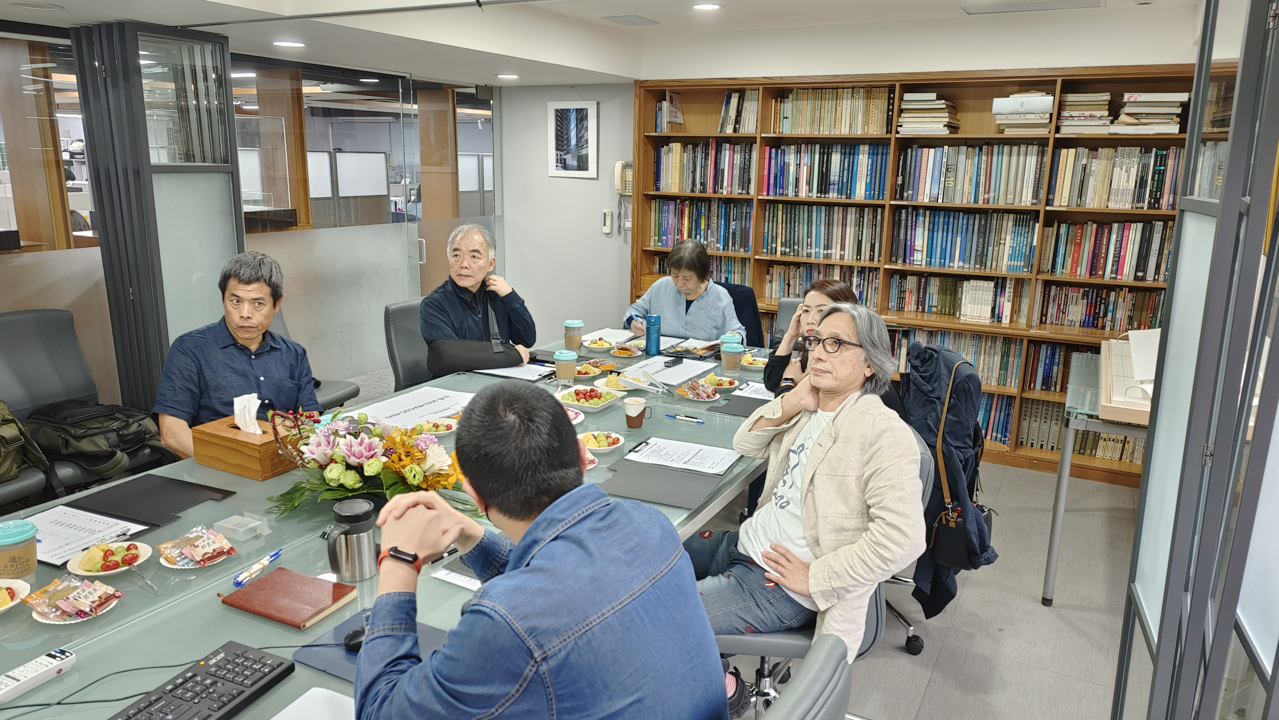
主席:黃長美/台灣住宅建築獎協會 理事、《TA》雜誌 總監
Host : Chang-Mei Huang / Director of Taiwan Residential Architecture Award Association, Director of 《TA》Magazine
與談人:
Keynote speaker :
甘銘源/大藏聯合建築師事務所 主持建築師
Ming-Yuan Kan / Host Architect of D.Z. Architects & Associates
林家如/OMA大都會建築事務所 台灣總監、建築師
Chia-Ju Lin / OMA Director TW/ Architect
曾成德/國立陽明交通大學建築研究所 終身講座教授
C-David Tseng / Lifetime University Chair Professor, Graduate Institute of Architecture, National Yang Ming Chiao Tung University
葉熾仁/後山建築人
Chih-Jen Yeh /architectural technician @ back mountain
(依姓名筆劃排列 Names are listed in the order of the number of strokes in their surnames)
整理:王進坤/台灣住宅建築獎協會 秘書長
Organizer : Chin-Kun Wang / Secretary General of Taiwan Residential Architecture Award Association
翻譯:蘇琨峯
Translate: Kun-Feng Su
時 間:2023年3月29日14:00-16:30
Time : 2023/03/29
王進坤:紙上住宅建築國際競圖(IRACDC)於2018年成立,今年是第三屆。前兩屆分別邀請山本理顯建築師,法蘭馨·侯班(Francine Houben)建築師擔任評審,本屆是邀請OMA的雷姆‧庫哈斯(Rem Koolhaas)與大衛‧希艾萊特(David Gianotten)兩位擔任評審。IRACDC是鼓勵四十歲以下的建築及相關產業之社會人士及學生,每屆由一位(組)評審出題並自行選出得獎者,透過兩年一屆及評審的目光來分析住宅建築的未來趨勢。於2021年舉辦第二屆時,正逢COVID-19爆發,因此評審Francine即以「住宅的未來–在大流感來臨之前與之後」為題進行徵件,藉此重新檢視人們的生活方式。本屆則已來到疫情末端,評審Rem跟David則以疫情後的建築發展趨勢為題,提出「多功能永續與健康宅」以三個重要議題,徵求新的住宅建築策略,最後共收到來自全球24個國家共274件作品參賽。
Chin-Kun Wang:International Residential Architecture Conceptual Design Competition (IRACDC)is founded in 2018 which is the 3rd session this year. Architects Riken Yamamoto and Francine Houben are the 1st and 2nd session separately, and architects Rem Koolhaas and David Gianotten are invited as the judges this year. IRACDC is aimed to encourage social elites and students under the age of 40 in the architecture-related industries. The topic will be contributed and the winners will be selected both by one (team) judge(s) in each time. The time of 2nd session coincides with the outbreak of COVID-19 which also becomes the topic of 「The Future of Housing-before and after a pandemic」by judge Francine to review the living way of people. The situation of pandemic is going to the end around the time of hosting the 3rd session. Therefore, judges Rem and David contribute the topic of 「 The Multifunctional Sustainable and Healthy Home」with 3 important issues which echoes the trend of architecture development to face the situation and brainstorm new strategy of residential architecture. All of the 274 submissions are received from 24 countries for the competition this year.
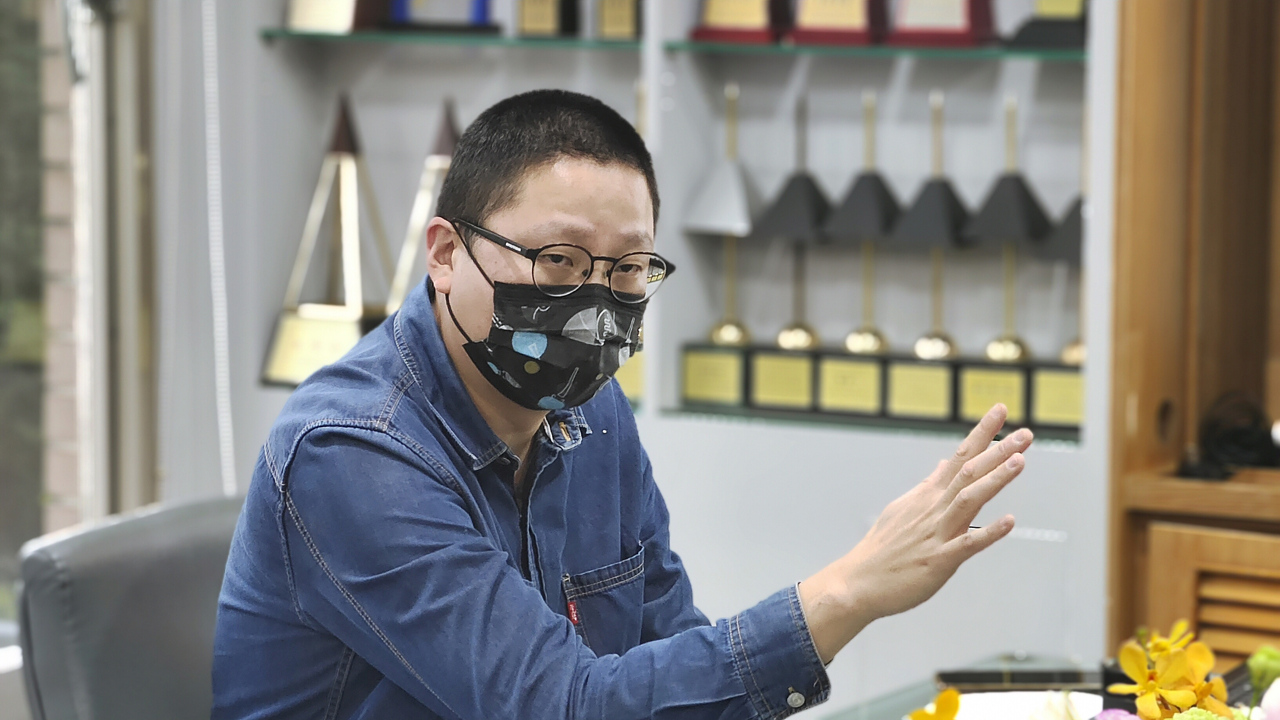
Chin-Kun Wang/photo: ta
黃長美:本屆兩位評審提出的題目「多功能永續與健康宅」及宣言,可說是他們對這個時代的觀察,並以此遴選出十件入圍及得獎作品。本座談會邀請四位建築學界及業界的工作者,第一是分享對COVID-19影響所導致住宅的演變,以及居住關係改變等面向來談。第二是對本屆十件入圍得獎的作品,所提出的概念及想法進行討論,尤其是在社會、經濟、永續及生活面上等。第三則是這些概念對建築實務界有怎樣的啟發,或可以進行實踐的?
Chang-Mei Huang:The topic of 「 The Multifunctional Sustainable and Healthy Home」and declaration by the 2 judges are from the observation of this era who select 10 shortlisted entries and winners. Four participants coming from architecture-related industry are invited in the forum to discuss the change of housing caused by COVID-19 and the change of relationship in residence for the first part. The 2nd part goes to the concepts and thoughts of the 10 shortlisted entries relating to society, economics, sustainability and life. The 3rd part is to discuss the inspiration or the direction of practice for architecture industry through the concepts.
林家如:雖然第二跟第三屆的題目都跟疫情有關,但有不同的關鍵字,像是「永續」跟「健康」,以及OMA關注十多年的議題「鄉村」,在疫情爆發前OMA更將這些成果整理成《鄉村,才是未來》(Countryside, The Future)於紐約古根漢美術館展出, 可惜後來就因疫情爆發而被迫暫停展覽,但鄉村已是當時不可迴避的課題。不同於主流研究推測全球人口會持續大量的往都市移動,促使都市越來越大,到2050年全球可能百分之八十以上的人都會居住在大都會區,當所有專業都在思考怎麼解決都市人口問題時,Covid-19疫情爆發,促使人們反向思考,選擇離開都市往郊區、鄉村移動定居的現象,也推動了建築專業重新重視鄉村議題的機會。而本屆Rem跟David選出的前三名作品都有扣合幾個關鍵字。
首獎Sky Village Incubator回應了鄉村農工因城市需要大量人力建設,而離開家鄉前往都市工作,卻因為疫情使建設變緩,讓這些農工陷入三不管的狀態,生活環境品質惡劣,她們為此提出解決方案,打造可自給自足的複合居住空間,讓農工在裡面居住的同時能付出擅長的種植技能。第二名POLAR STOROZHKA則位在俄羅斯寒冷的極區,建立一棟像堡壘的群居住宅創造共生,提出集居方式的一種可能性。第三名Carbon Lab of Circular Economy也是在創造一種群居的生活方式,不同的是她是透過居住機器本身能轉化製造生活所需的能源,空間上則採用流通開放去跟自然合為一體,基地也更有機會落腳在鄉村而不是都會區。
Chia-Ju Lin:Although the topic of the 2nd and 3rd session are both related to the pandemic, we can see different key words, such as "sustainability" and "health" and the topic of "countryside" which OMA has been discussing for over a decade. Before the pandemic outbreak, OMA even organizes the results into an exhibition called "Countryside, The Future" at the Guggenheim Museum in New York. Unfortunately, the exhibition was forced to be suspended due to the pandemic but the issue of the countryside was already an unavoidable topic at that time. A different thinking is from the mainstream study that predicts a continued large-scale migration of the global population to urban areas which will make the scale of cities larger than ever. There is a possibility that 80% of the world's population may live in metropolitan areas by 2050. While all professionals focus on how to solve urban population problems, the outbreak of Covid-19 pushes people to have a reverse thinking of choosing to move to suburbs and rural areas. The situation also becomes an opportunity to push architecture professionals to review the issue of countryside. The top 3 shortlisted projects selected by Rem and David also response several key words.
The first-place winner, Sky Village Incubator, mentions the situation of rural farmers and workers leaving their hometowns to work in cities due to the demand of large workforce in urban construction. However, the process of construction goes slower caused by the pandemic and the rural workers are neglected with poor living conditions. The team proposes a solution of creating a self-sufficient and multi-functional living space where rural farmers and workers can live and using their planting skills. The second-place winner, POLAR STOROZHKA, which is located in the cold polar region of Russia, creates a possibility of group living of building a fortress-like housing. The third-place winner, Carbon Lab of Circular Economy, also creates a communal living style. However, the designer focuses on utilizing machines to transform energy for daily necessities and using open spaces for circulation to better connect nature to locate the site of project in rural areas rather than metropolitan areas.
曾成德:首獎對中國「城中村」狀態進行提問,關懷居住在裡面狀況不佳的居民。中國應是全球都市跟農村差距(薪資及福利)最大的國家,過去曾多次對城中村進行清理,卻導致城市的服務系統癱瘓,而這個問題即是因貧富差異懸殊而來,過去由上而下的方式並無法解決這個問題。這次首獎團隊提出的策略,是想在裡面找出合理的方案,以農工擅長的種植技能補足都市的缺乏,再透過模具化、土地整合等方式建構。但在建築上提出的想法是用較老派的多米諾系統(Domino),於一層層的架構中植入一棟棟小房子,相對較沒有新意。但整體上去觸碰中國正面臨的問題,由下而上提出解決方案,回應永續、健康及鄉村等議題,是非常整齊的,比較可惜的是對維運系統,譬如構造、農耕、能源及廢棄物回收等地討論較少。
第三名團隊的議題及解決策略整體也很完善,但相較於首獎還是較不足。因首獎提出的系統雖然是既有的概念,但架構具備多變性,可因應需求而調整,反觀第三名則是要仰賴未來3D列印技術的突破,再去用機械去創造形式,藉此更自由地提供居住平面,來彈性滿足需求。再來以Carbon Capture為題,希望藉捕捉碳足跡達到循環經濟,但提出的方案規模不夠,是很難達到的。而首獎的提案則因中國規模大,且農工問題是實質存在,會讓人去思考。
C-David Tseng:The first-place winner questions the situation of “villages in cities “and takes care the residents with poor living conditions. China should be the country having the largest gap between urban and rural areas (income and welfare) in the world. Meanwhile, the action of reorganizing villages in cities several times in the past has paralyzed the city's service system. The problem actually is derived from the gap between wealth and poor. Therefore, the top-down management cannot solve the problem. The strategy proposed by the first-place winner this time is to find reasonable solutions and use planting skills of farmers and workers to supplement the urban deficiencies and build the mechanism by modularization and land integration. However, the relative unoriginal idea is to use old-fashioned domino system to place small houses in stack system. Nevertheless, it is integral to touch the problem China is facing by bottom-up solutions to response issues of sustainability, health, and rural villages. It is pity that we do not see more discussions on operational systems such as structure, agriculture, energy, and waste management.
The third-place team's topic and solution are also well-developed, but they are still lack of integrity compared to the first-place winner. Although the system proposed by the first-place winner is not a new one, the structure is flexible to be adjusted be demand. In contrast, the third-place winner relies on breakthrough in future 3D printing technology to create forms with machines to provide living spaces more freely and meet demands flexibly. Moreover, the idea of Carbon capture is used to try to match the circular economy by capturing carbon footprints. The relative smaller scale of proposal is hardly to achieve the result. In comparison, we are interested in the first-place winner's proposal because of the large-scale system in China with the real problem of rural farmers and workers at the same time.
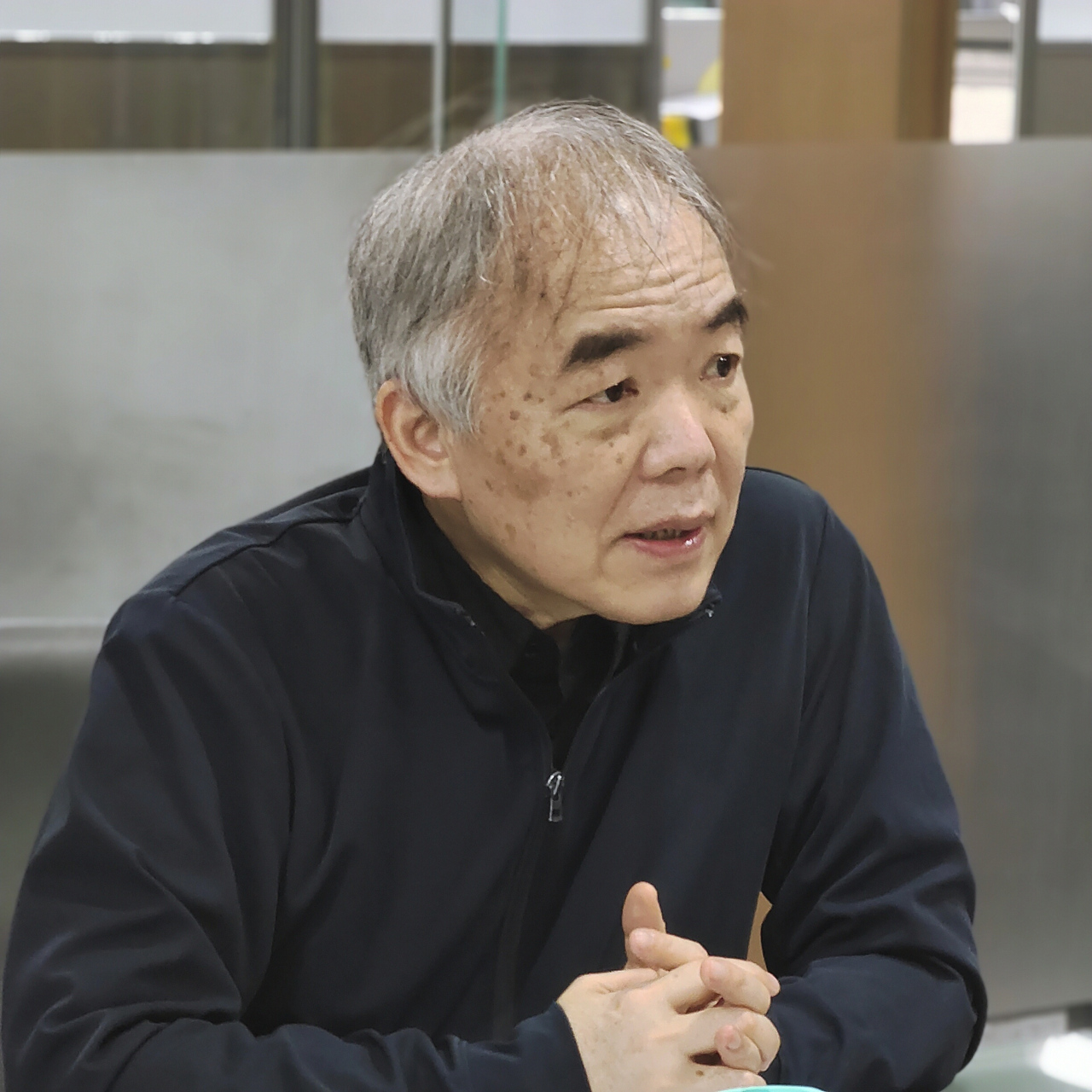
C-David Tseng/photo: ta
黃長美:上屆競圖時是疫情還在高峰,這屆則已在疫情尾端,所以參賽作品提出的議題跟解決策略也不同。上屆的作品比較強調保護跟安全,意圖在保持安全距離下,仍能進行交流。本屆則比較會從都市、社會及住宅趨勢切入,而且OMA的題目也很具體在「多功能」、「永續」跟「健康」上,整體來說作品有聚焦在都市、鄉村等社會議題,但對永續跟健康兩個議題的發揮較少,且健康也不應僅是身體也是心理上,我認為這次競圖的三個議題都很關鍵,是當下建築界必須思考的課題。
Chang-Mei Huang:The pandemic is still at its peak when hosting the 2nd session but the pandemic is going to the end for this year’s session relatively. Therefore, the topics and strategies raised by participants are different. Last projects more focus on protection and safety which is to keep a safe distance for communication. The projects this year seems to focus more on urban, social, and housing trends and OMA’s topic physically raises the issue of “multi-function”, “sustainability” and “healthy”. In general, all of projects focus on issues of urban and rural villages but lack of 2 issues of sustainability and healthy which should be considered both for physical and psychologic level. I believe that the 3 issues of this competition are critical which should be considered for architecture industry in the moment.
葉熾仁:生活、居住是人類的日常,但永遠是推動我們往前探索的起點。我認為現在並不比古人輕鬆,雖然已有些基礎,譬如人口結構、土地利用、經濟模式到數位科技及居住形式,但居住樣貌在未來可能會逐漸模糊,因3D列印、AI等技術的成熟,幾乎能解決所有的「題目」,那建築人未來應該要擔任怎樣的角色?是藉此去尋找桃花源?還是會被物(科技)所役?這是一個大哉問。但未來還需要用「城市」、「鄉村」這二分法來思考問題嗎?是要水平發展?還是垂直發展呢?譬如建立巨型結構,然後把要探索的如永續、綠建築等塞進去,再藉過濾讓空氣乾淨,但這樣適切嗎?還是因為有科技輔助,人類更該直接回歸到自然環境,變成散居的生活模式。如此說是因人類的居住形式其實有很大的想像空間,但因為這是競圖有一個題目,所以必須要破題,但若把這些想法納入思考大膽假設,提出對空間形式的見解,未來再面對疫情時可以控而不封,思考人跟人之間到底該用怎樣的居住形式,需要控制時就控制,要開放就開放,藉由科技解決醫療照護的問題,是利用科技讓生活更好,而不是因科技造成更多麻煩跟困擾。
首獎作品是一個具政治跟社會特殊性的問題,且不是農工而是農民工,是從鄉村到城市的,舉上海為例若不是上海居民,在封控時就會因不在民單裡而造成生活問題,為解決這個問題團隊貼心的建構一個系統,不但提供居住空間還讓他們可以發揮農務經驗,但若把觀點從社會性抽開,而是去看有無造就了可以放諸四海而皆準的創意,這次十件入選的作品多是很特定的,譬如重新設計晴光市場,那就是特定的場域,無法運用到另外一個文化、另外一個社會、另外一個環境裡,既然競圖已經結束,我建議是把討論展開,不要只談論這些作品提出的議題。
Chih-Jen Yeh:Living and accommodation are daily life for human beings but they are always the starting point to push us to move forward. I believe that the life nowadays is not easier than ancient people even though we have had some foundations such as population structure, land use, economic models, digital technology, and housing forms. However, the appearance of housing may gradually become blurred in the future due to the maturity of technologies such as 3D printing and AI, which seems like can solve all "problems". Hence, what the roles architects should play in the future?Is it the time we can go to find an utopia? Or being enslaved by objects(technology)? It is a big question. However, do we still think about questions by binary method of “city” and “rural village”? Horizontal development? Vertical development? For example, we build a gigantic structure and putting elements such as sustainability and green architecture into it, then have clean air through filtration. Is it the correct way? Participants have to solve the named topic in the competition. However, if the ideas could be involved with bold hypotheses to provide viewpoint for space forms. When the next pandemic comes again, we can control it instead of lockdown and think about what is the living style for people. We can control the situation when it is necessary, open it when it is needed and use technology to solve healthcare problems. Technology is used to make life better instead of causing more problems and difficulties.
The first-place winner’s project discusses an unique issue of politics and society, and it's not about farmers but about farmers and workers who migrant workers who move from rural to urban areas. Shanghai for example, if someone is not registered as a resident of Shanghai, they may face living problems during lockdowns. The team specially build a system that not only provides living spaces but also allows them to utilize their farming experience. If the sociality is drawn out of the viewpoint and check whether an idea of creation is made with universal values. We can see most of the 10 shortlisted projects are unique. The redesign of Qingguang Market for example, it is a special area which cannot be applied to another culture, society or environment. Although the competition is ended, I suggest that we can expand the horizon of discussion instead of merely focusing on issues raised by the projects.
黃長美:剛葉熾仁講的那個控而不封,其實國外都市規劃已開始推動十五分鐘生活圈,讓生活及醫療等需求的空間在這範圍內都有,因此若疫情爆發,人的需求在生活圈內就可滿足。由於中國的小區都非常大,一封控就造成很大的影響,未來應是要朝向十五分鐘的生活圈邁進。
Chang-Mei Huang:For the concept of controlling it instead of lockdown mentioned by Ye Chi Ren, the idea of 15-min living circle has been launched in foreign urban plans earlier. All of spaces of living and medical treatment can be found in the scope of urban plan to meet people’s demand when pandemic outbreak comes. The so-called small districts in China are actually quite large which will be affected hard by lockdown. The concept of 15-min living circle should be adopted in the future.
葉熾仁:我滿喜歡十五分鐘生活圈的想法,但現在有另一種可能出現,就是用無人機去運送需求,不再是計算人行的時間,這跳脫了我們的思考框架,所以未來人回到自然的桃花源是可能的。因為數位世界無遠弗屆,是沒有疆界的,人的社交型態也將被改變,讓人回到自然環境裡。但數位世界雖然提倡追求自由,但另一面讓人擔憂的易被監控,透過AI就可洞悉我們想做的事情,因此在不遠的未來,安生立命將不再只是「選(設計)一間房子住」。過去因為人口高速成長,因此有急迫性怕房子不夠,但若把全球人口結構拆解來看,其實先進國家的都市人口已開始衰減,加上這些國家居住密度最高,人口衰減造成許多無人照護的餘屋,現在談閒置空間再利用其實還挺美好的. 但當社會有太多這樣的空間時,那就變成嚴重的社會問題,所以看一件事情的角度,不能這麼單純,包括碳足跡、淨零排碳等都是,必須省思是否真的理解其意義,不要為了做這些反而造成更多浪費,譬如政府推動的標章制度就是這樣,這次競圖題目給我的反思,反而是在這部分。
Chih-Jen Yeh:I like the concept of a 15-minute living circle, but there's another possibility that using drones to deliver demands instead of calculating the time of workforce. It is a kind of thinking out of box so it's possible for people to return to a natural utopia. The digital world has no boundaries and out of imagination so people's social styles will also be changed to allow them to return to the natural environment.
Although digital world aims to promote freedom, surveillance issues also become the problems we worry about. With the use of AI, our actions and intentions may become more predictable and easier to monitor. As a result, a peaceful life will not only “choose (design) a house” in the near future. In the past, the rapid population growth brings a worrying of the housing demand could not be enough. However, if we break down the global population structure, we can find the urban population in advanced countries has started to decline. Although these countries have highest population density, the population decline brings a problem of many vacant houses without care. It is a good timing to talk about the vacant spaces actually.
When there are too many such spaces in society, it becomes a serious social problem. Therefore, we should handle an issue with more aspects such as carbon footprint and zero-carbon emissions. We must think thoroughly on whether we indeed understand the meaning or just waste resources. The government-driven certification systems could be such the problem. This is the reflection from the topic of competition for me, precisely in this part.
甘銘源:我長期住在鄉下地方,現在住雲林快二十年。首獎的作品讓我聯想到近年中國房地產崩盤後,留下許多無法蓋完的爛尾樓,一直維持在未完成的狀態,但裡面是有住戶的,且這些人都還要繼續繳十幾年的房貸,也沒有其他地方可以去,變成一種活著的廢墟。中國農民的身分有個特性,時常在農民跟工人兩個角色切換,農忙時回家種地,農閒時就進城打工。若居住的本質是安身立命,那農民工是具有構築跟種植的能力,是能餵飽自己的,但在原本的城市系統中卻沒辦法展現,而這件作品就是整合這兩點,讓在社會底層被割韭菜的勞動者,也能被都市接受。但這其實是個陷阱,因農民工仍必須居住在高密都的都市,及負擔這樣高房價的住宅,所以是滿反諷的,我認為這並非是未來的美好想像。
雲林斗六其實很類似於十五分鐘生活圈,斗六約為六至七萬人的小鎮,公共運輸有鐵路,教育有雲林科大,基本產業繞在學校周邊,是十五至二十分鐘就可涵蓋的,我則住在距離斗六車程二十分鐘的山上。我認為「家」是給人安身立命的地方,讓自己能從自然條件中得到療癒消解壓力,待在家裡不用積極的安排,就能得到充電。我居住的地方有座有機農場,內部設有共享商店,也提供類便利商店的服務,可以收寄包裹,我認為這是後疫情時代理想的居住方式跟環境。從永續或社會觀點來看,這樣人口低密度的地區,反而是比較容易實踐的場域。
Ming-Yuan Kan:It has been a long time for me living in rural areas of Yunlin for almost 20 years. The first-place winner’s project reminds me of many unfinished buildings left after the collapse of Chinese real estate market in recent years which remain incomplete. There are still residents inside and need to continue to pay off their mortgages for over a decade then. They have nowhere to go and the ruined buildings are still alive. It is special for the identification of Chinese farmers which could often change between farmers and works. They do farming or do part-time jobs in the peak time or the weak time of farming respectively. If the essence of living is to have a place to live in peace, farmers and workers have the ability to build and cultivate to make life for themselves. However, the situation is unable to work in the original urban system. This project integrates these two points, allowing the laborers who are being exploited at the bottom of society to be accepted by the city as well. However, this is actually a trap because farmers and workers still have to live in dense populated cities and bear the high housing prices. It is quite ironic and I do not believe it will be a beautiful vision in the future.
Douliu of Yunlin actually has a situation similar to the 15-minute living style. Douliu is a small town with a population of around 60,000 to 70,000. The down has railway system for public transportation and National Yunlin University of Science and Technology for education. The basic industries are centered around schools area which can be covered within 15 to 20 minutes by cars. My house is on a mountain about a 20-minute drive from Douliu.
I believe that "home" is a place where people can settle down and live in peace, allowing themselves to live comfortably and relieve stress in natural environment. Home is a place to refresh ourselves without any plan in advance. There is an organic farm with a shared store offering services similar to convenience stores to provide package shipping and receiving. I believe that this is an ideal living style and environment in the post-pandemic era. For sustainability or social perspective, such a low-density area like this one is actually easier to implement.
林家如:過去會認為人口往大都會集中是常態,但被疫情打破之後,人開始嚮往要自由的空間、乾淨的空氣,而往郊區移動,但這就是好的嗎?若拋開本位,人類蠻像是地球的病毒,而大城市則是將這些病毒集中在一個可控的範圍。鄉村目前是處在一個平衡的狀態,越低程度涉入干涉越好,當因為疫情造成人開始往鄉村移動,就需要看提出了怎麼的方式去移居。而不論是首獎、第二名跟第三名的作品,我認為人移居鄉村仍要建立系統去控制,若移居到鄉村仍像在都市般圈地蓋房子,那只是破壞鄉村,故怎麼用最少限度地介入鄉村,必須先建立正確的態度。
全球許多城市人口都有衰退的趨勢,像台北已超過六年人口負成長,將造成包括空屋率,高齡化等問題。Rem在《The City in the City》一書中,研究德國柏林這個城市,他提議政府不要去干涉人口衰退,就讓房子荒廢讓植物來佔據,如此城市就會出現一群群的綠色叢林,讓自然回歸到城市裡達到平衡。但這樣是好的嗎?而且台灣的狀況其實滿獨特,是屬於非城非鄉的。像鄰國日本因為人口往都市集中,造成鄉村人口老化,很早就嘗試包括地方創生的方式,意圖解決但都無法成功,卻沒想到因為COVID-19的關係,這些問題一下就沒了,鄉村的房屋變的搶手,人開始嚮往農村生活,但我們還未想出一種方法,讓人能好好地回歸自然,與自然共存,是時候建築師也需要開始將專業擴展,思考城市之外的變化了。
Chia-Ju Lin:In the past, it is believed that population concentrated in metropolitan areas is normal. In contrast, people start to yearn for free space and clean air and move to the suburbs after the pandemic outbreak. But is this correct? If we disregard self-respect of human beings, people are like viruses on Earth, and big cities are places to control and concentrate these viruses. Currently, rural areas are in a state of balance which will be going better with less intervention. When people start to move to the countryside due to the pandemic, it is necessary to consider the way of migration. Regardless of the first, second, or third-place project, I believe that a system should be built to control the migration to rural areas. If people follow that way of building housing the same as in cities, it will only harm the rural areas. Therefore, how to limit the intervention in rural areas is the correct attitude we should have.
Many cities around the world are experiencing a declining population trend, and Taipei has a negative population growth for over six years leading to issues such as vacancy rates and aging population. In the book "The City in the City," Rem Koolhaas studies the city of Berlin in Germany and suggests that the government should not intervene in the population decline and allow houses to be abandoned and occupied by plants. A scenery would be seen of groups of green forests in the city and allow nature to return to the city and achieve balance.
However, is the idea good? Taiwan's situation is quite unique which cannot be categorized as cities or rural villages correctly. For neighboring Japan, the concentration of population in cities has led to aging populations in rural villages. The areas has tried to conduct local revitalization programs for a long time to figure out the problem but failed. Unexpectedly, the COVID-19 helps to solve the problem to raise value of house in rural areas and bring a phenomenon of wonderful rural life for people. Yet, we have not found a way for people to return to nature and live with it in a suitable manner. It is time for architects to expand their expertise and think about changes beyond the city.
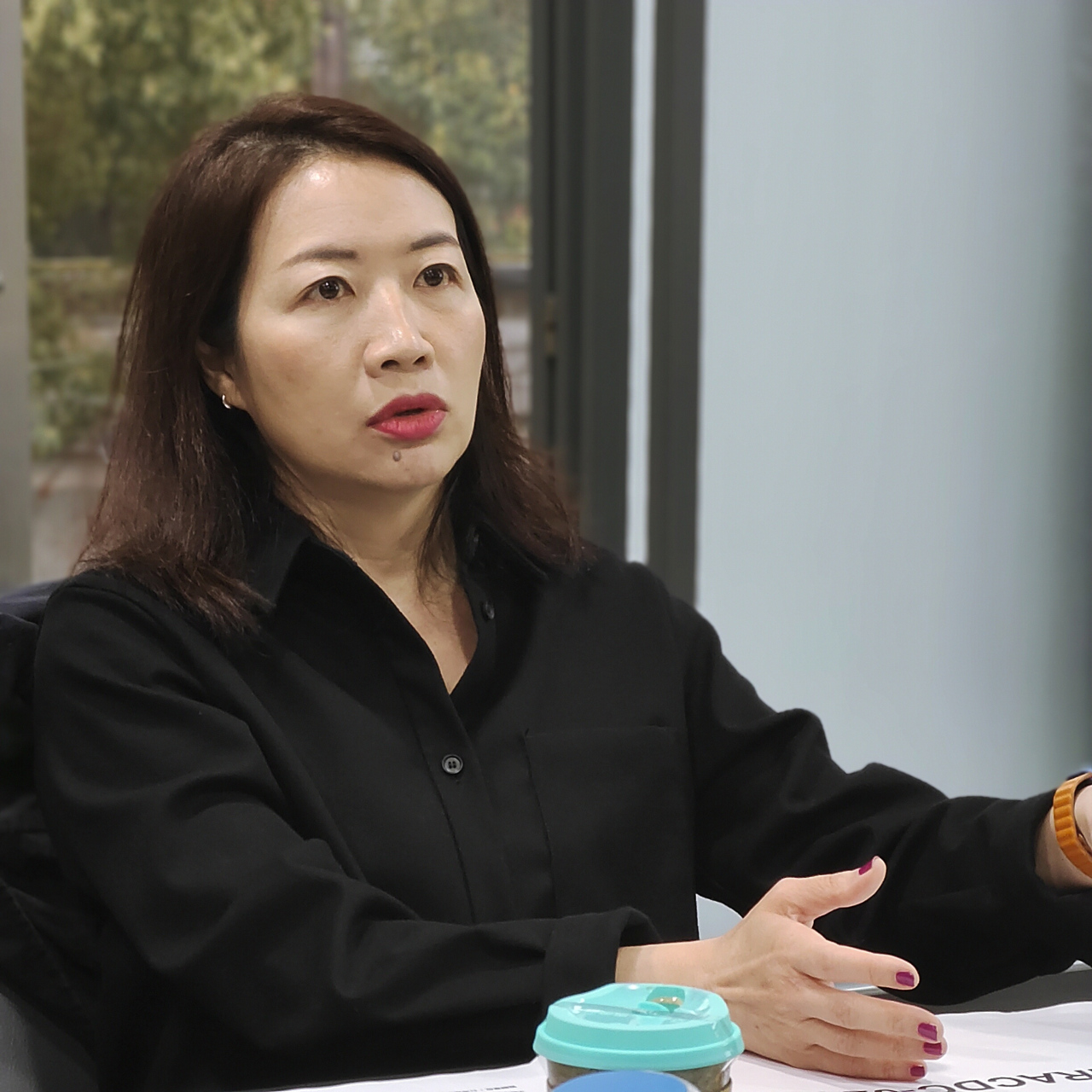
Chia-Ju Lin/photo: ta
葉熾仁:在一兩千年前其實沒有垃圾、沒有汙染這些概念,所以應該先回到最初始的狀態來找解答,現在的方法是用科技手段去解決科技所產生之害,但目前看這只是造成輪迴,並無法解決問題,所以最後其實仍是「人」的問題。科技永遠是雙面刃,帶來方便性的同時也帶來無法預測的災難,譬如推動綠建築而制定的標章規範,最後為達到標章,其實做了許多不環保的事情。當要開始進入數位化世界,那我們該如何自處?過去安身立命的條件,現在是否依然算數?要如何安養?醫療機制的配套是?要繼續用格子框架的方式,指定這個是醫療、那裡是學校,還是要採用有機的、療癒的方式規劃?
由於科技的發達,住在鄉村也能透過線上訂購跟宅配的方式取得需求,讓鄉村跟城市的界線模糊,當距離的問題被消除,COVID-19讓人開始思考去中心化跟全球化,全球化不僅是談製造業的供應鏈,而是與生活息息相關,疫情已讓全球化被質疑,而開始轉向去中心化,譬如元宇宙、數位貨幣及NFT等都是去中心化的流程,我們必須思考去中心化背後的意義,然後想像這些在未來將變成日常。就如同1990-2000年時,當時網路及視訊等開始出現,但還未真正運要到民間,所以並不是科技到底能多進步,而是我們該如何運用,我們是否具備視野去使用,是擔任使用者?還是被科技奴役者?
Chih-Jen Yeh:There is no concept of garbage or pollution a thousand or two thousand years ago. The solution should be found in the ancient situation. Nowadays we use technology to solve problem caused by technology but it seems like an endless circle without ending. “Human beings” is actually the real problem.
As technology is always a double-edged sword, it not only brings us convenience but also unpredictable disasters. For example, when we promote green building certification standards, we actually do many unfriendly-environment things at the same time. Where is our position when we begin to enter the digital world? Does it still count the situation of living in peace in the past? How do we take care of ourselves? What are supporting measures of medical system? Should we continue to use the concept of grid designate certain areas specially for medical or educational units, or should we adopt an organic, healing approach for plans?
甘銘源:看第二名的作品時,聯想到自己曾待過加拿大北部,那裡的氣候挑戰極大,室內外溫差常在三十度以上,在那樣的環境裡非常容易得到憂鬱症,因為沒辦法進行戶外的活動,所以她提出的策略跟解法是成立的,外牆的保溫設計很重要,生活在亞熱帶的我們,並不容易去想像在寒帶生活的感受。而首獎的作品我認為反諷的原因,是中國花費巨大的資源蓋商品房,事實上造成非常多的空屋,但有需要的農民工卻都負擔不起,而他們卻又是這些商品房的建造者。中國利用城市戶口跟鄉村戶口來管制整個國家,沒有城市戶口者的農民工非常可憐,是沒有教育、沒有醫療,所有城市的服務都無法使用,是被壓榨剝削的對象,因此這個提案是非常烏托邦的。
Ming-Yuan Kan:When I review the second-place project, it reminded me of my experience in the northern part of Canada. The climate challenges are extreme and the gap of temperature often goes to more than thirty degrees between indoor and outdoor. It's easy to develop depression because outdoor activities are limited in such an environment. So the strategies and solutions are accepted to design an important insulation in outer walls. For those of us who live in subtropical regions, it's difficult to imagine what is the life in cold climates. The ironic reason for the first-place project is that Chinese government spends lots of resources to build commercial housing but actually results in a large number of vacant houses that many rural farmers and workers cannot afford. However, they build these houses. Chinese government uses urban and rural household registration to control the entire country. The situation is poor for the farmers and workers without household registration who are unable to have education or medical services or any urban amenities. They are exploited and the proposal is quite utopian.
葉熾仁:不一定是反諷,也可能是一種想望,內心是真的很希望要這樣子。因為農民工在城市裡是非常弱勢的,所以希望能給他們一個機會,但這個機會目前在政治體系、政治學底下是不被允許的。
Chih-Jen Yeh:It is not really ironic but maybe a desire in heart. We sincerely hope farmers and workers could have an opportunity since being a group of minority. However, this opportunity is not allowed in the current politic system.
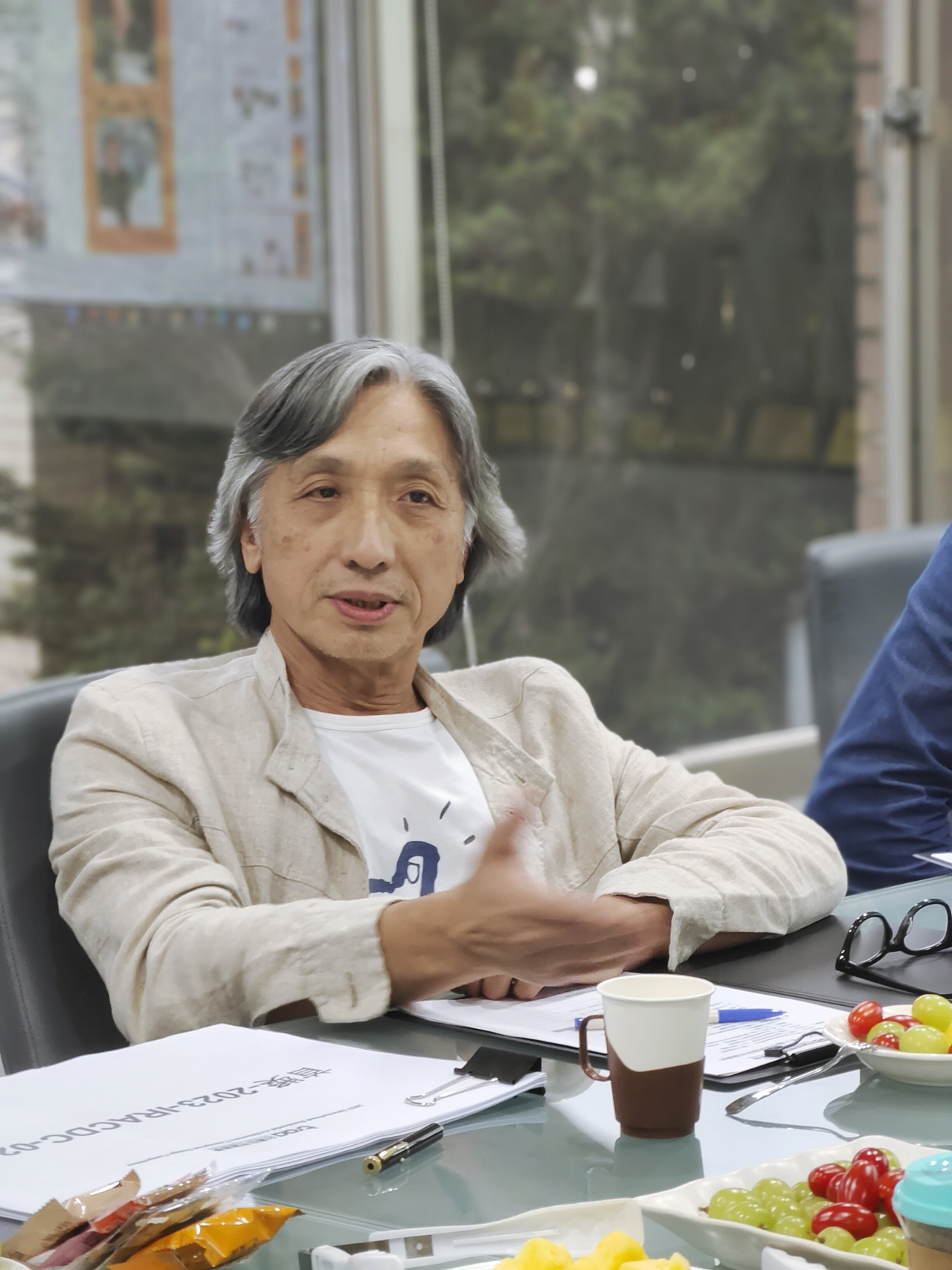
Chih-Jen Yeh/photo: ta
曾成德:我試著拉遠一點,整個20世紀在追求現代主義建築時,自1928年的白屋計畫(Weissenhof Estate)、1932年MOMA的「現代建築:國際主義展」(Modern Architecture: International Exhibition)等等,都是以住宅為主題出發。當代建築史論家 Beatriz Colomina 說過一句話有趣的話,大意是:「實驗建築或是前衛建築,最好的方法是用住宅來提案」,這句話背後的意思是住宅是為人所熟知的建築類型,它就是滿足居住的需求、回應生活的基本機能,因此建築師在捕捉一般人都也理解的這些基本條件後便得以開始實驗,透過可能是形式、語言及建造方式等,比如在國際現代建築協會(CIAM)第二次會議中,就討論最小的居住單元應是多大。因此這個競圖最美好的地方,是藉由評審拋出的議題去探索住宅的可能性,讓參加者思考住宅是什麼。
可惜本屆這十件入圍作品多在解答永續跟多功能上,在健康這部分是沒有回答的,可能是還太年輕且健康而無法感受,或還無法關照建築所有的事情。自1990年代中起,建築圈的人逐漸發現建築從來不是形式、不是語言的問題,而是跟社會、跟經濟系統有關。首獎的作品企圖為農民工解決問題,這個立意非常好,雖然回應的系統並不完善,仍值得鼓勵。第二名則是回應寒冷氣候,提出雙層牆來保暖,並於中庭種樹來凝聚住戶意識,雖然這個系統也未交代清楚,但這個想像力跟創造性是很棒的,但欠缺的就是對健康及幸福感的回應較少。
C-David Tseng:I try to look back further that the hot modernism of architecture in the whole the 20th century is the base of housing theme such as Weissenhof Estate in 1928 or Modern Architecture: International Exhibition in MOMA in 1932. Contemporary critic of architectural history Beatriz Colomina once said an interesting statement that goes something like: "The best way to propose experimental or avant-garde architecture is the housing." The meaning behind the words is that housing is a familiar architectural type for people to meet people’s basic function of accommodation and responds to basic mechanism of life. Therefore, after architects capture these basic conditions that most people understand, they can begin to experiment may through forms, languages and construction methods. For example, the second conference of the International Congress of Modern Architecture (CIAM) discusses the minimum size of a housing unit. Therefore, the best part of this competition is that participants try to explore possibilities of housing through the issues raised by the judges and encourage participants think about what is housing.
Unfortunately, the ten shortlisted projects in this competition mainly focus on sustainability and multifunctionality, lacking of health. Perhaps the reason is that the participants are healthy and too young to feel the part, or may not yet having the capacity to take care all aspects of architecture.
Since the mid-1990s, people in the architecture industry have gradually realized that the problem of architecture does not come form form or language, but connects with society and economic systems. The first-place project attempts to solve problems for farmers and workers which is a very good idea. Although the response of the system is not perfect, it is still worthy of encouragement. The second-place winner responds to cold climates, proposing a double-layered wall for insulation and planting trees in the courtyard to unite the residents' consciousness. Although this system is not clearly explained, the imagination and creativity are great, but the idea lacks of responding to health and happiness.
林家如:因我擔任OMA的台灣總監,故Rem跟David也有請我跟他們一起看所有參賽的作品,雖然競賽是匿名的,但從圖面表現上還是大概能分辨出有些明顯是台灣學生的作品,雖然數量不少,但以結果來說比例並沒有特別佔優勢,可能是現在台灣的學生對住宅建築不感興趣。觀察台灣畢業設計多年,感覺比較少有設計能力非常優秀的學生選住宅當題目,也許是覺得表現性不夠?而很多投稿的學生看到出來可能是大三左右,但也因為還在學習的中段,所以手上的技能跟思考的議題都不夠廣,導致論述性跟表現都比較弱。再來是我觀察Rem跟David偏好複合性議題,且系統要複雜、規模要大的設計,因此有些台灣參賽者提出思索居住性的有趣案子,似乎都因規模比較小,而未獲得兩位評審的青睞。中國的投件數量很多,且大多採團隊方式,因此圖面品質較好也較完整,因此在評選時比較有利。
我印象深刻的是榮譽獎Urban Instability,團隊針對晴光市場進行研究,然後用非傳統的方式進行設計,是將「元宇宙」實體化,透過提供住戶app,去調整空間成自己喜歡的樣子,來將建築的限制打破,並透過圖面說明怎麼去調動。Rem決選時問他,雖然有app可去調整,但這些家具跟空間的尺度還是必須被設定,因此仍然有框架,人必須依著設定去選擇,那這樣的空間對人還有自由嗎?我覺得是給這位學生一個很有趣的質問。我也喜歡德國的入圍作品Four Filtering Pieces House,雖然他提出的策略比較老派,但他透過將建築物切成四層,讓每一層都有自己的功能,最外圍臨街面的是半開放的空間,第三層則是公共空間,第二層則是內部的交誼空間,最後一層是住宅空間,藉此處理開放、公共到私密空間的關係,非常簡單的手法但很有趣。
Chia-Ju Lin:I am the director of OMA in Taiwan so Rem and David invite me to review all of projects submitted. Although all of participants are anonymous, I still can roughly tell which projects submitted by Taiwanese students from the drawings. Although the number of entries is large by comparison, they do not have advantage by the proportion of submission. The result shows that maybe students in Taiwan are not interested in residential architecture. For reviewing graduation projects in Taiwan for many years, it seems that there are relatively few students with excellent design abilities to choose housing as their topics. Perhaps they feel the performance of housing design is not strong enough? Many of the submitted projects of students who are around the third-year degree of study. It is the time in the middle of their learning process and their skills and thoughts are not mature on the topic with weaker presentations and expressions.Furthermore, I can see that Rem and David prefer complex and large-scale designs with multiple issues. Therefore, some Taiwanese participants propose interesting ideas about thinking the way of residential living but may not have been favored by the judges due to the smaller scale of their designs. On the other hand, there were many submissions from China of which most are done by teams, providing higher quality and more complete drawings. Their preparations have an advantage for the judging.
I am impressed by the Honorable Mention project "Urban Instability", in which the team conducted research on the Qingguang Market and then uses a non-traditional design. They materialized the concept of "metaverse" and provides residents with an app to adjust the space to meet their preferences and break the limitations of the building. The team also explain the way of adjustment through drawings. During the final selection, Rem asks him that although the app can be used to do adjustment, the furniture and space scale still have to be controlled. We can see a framework there and people have to make choices based on those settings. If so, people can still feel free in such space? I think it is an interesting question for the student. I also liked the Four Filtering Pieces House from Germany which proposed a more traditional strategy but the building is sliced into four layers with its own function for each. The outermost layer facing the street is a semi-open space, the third layer is a public space, the second layer is an indoor social space and the last layer is a residential space. This simple technique effectively handled the relationship between open, public, and private spaces. The relationship among open, public and private space is handled which is a simple and interesting way.
曾成德:晴光市場這件作品是有處理系統,包括空氣流動及各項設備等,但Rem提出的是個好問題,我自己也無法回答,因已經假設app可以解決空間自由配置的問題。而Four Filtering Pieces House的概念,設計者用標題FFPH就講完了,動作簡單且圖面也繪製有趣,比較可惜的是對社會、政治及經濟議題相對比較少。
C-David Tseng:There are operational systems in the project for Qingguang Market, including air circulation and other equipment. However, Ren gives a good question which I could not answer as well because of the assumption of the space arrangement being handled by app. The article of project FFPH has explained the concept of Four Filtering Pieces House. The idea is simple and the drawings are interesting. Unfortunately, the issues of society, politics and economics are less discussed.
葉熾仁:我對第二名很有興趣,很想知道她的心理狀態。因兩位評審有問妳是住在那邊嗎?或去過那邊嗎?但她回答都沒有,所以是用假設去回應極地狀態。第二是她用了巴比倫塔的概念,將抽象的意涵投射到未知的極地狀態裡。可惜,最後手繪的建築體跟平面還是滿制式的,所以會有衝突感,不知怎麼會去做這樣設計的選擇。這次入選的十件作品,對住宅平面沒有太多著墨,還是依循著過去,但現在科技已改變我們的行為,譬如滑手機低頭去迴避視線,保持社交距離等,而在這樣的現況下還需要客廳嗎?就算仍保留但功能應該也已改變,紙上競圖的目的應該就是去激發討論,打破這些既有的疆界。
榮譽獎Urban Instability - Participatory Urbanism的名稱instability是指不穩定,藉此談在不同時段裡人口密度、活動及群體等的不穩定,透過他們設計的系統讓人能因時、因地及因人而有不同活動的可能性。但人是不可測的,所以意圖透過app讓人變成可測,但有趣的應是透過這個想法去實驗人的行為,去理解這不可測性,而不是發展複雜的形式。雖然圖面表達精彩,但會讓人遲疑是否相信。入圍作品Alveolar Filter提出了一個想法,透過巨型的吸氣管去過濾空氣,讓人在室內就可呼吸最乾淨、清新的空氣,這是他們對COVID-19疫情提出的解方跟思考。但競圖的題目其實有個更重要的精神,是開始思考若爆發下一個疫情時,該怎麼去回應,與其用這麼具體的手法。我更希望是去展開,藉競圖去引發對未來都市、鄉村的思索可能性,然後是能落實被應用。
Chih-Jen Yeh:I am interested in the second-place winner and would like to know more about her psychological state. During the Q&A time, both judges ask her if she had lived or visited the area she designed for and she replies that she had not. Therefore, she responds to the polar conditions using hypotheses. Secondly, she uses the abstract concept of the Tower of Babel for the project with unknown polar conditions. It's a pity that the final hand-drawn drawings of building and floor plans seem from format, leading to a sense of conflict. I have no idea why they make the choice of design. Among the ten selected projects, there are not much emphasis on residential plans and just following traditional styles. However, technology has changed our behavior such as looking down at our mobilephones to avoid eye contact and maintaining social distancing. Do we still need a living room in this situation? Even if the function still need to be kept, it should be changed. The purpose of conceptual design competition should inspire discussion and break down these existing boundaries.
The word of instability in Honorable Mention project "Urban Instability - Participatory Urbanism" means instability which is to discuss population density, activities and groups at different times. People can have different possibilities of activities based on time, location and people by their design. People is unpredictable. Therefore, sesigners try to make it predictable by App but the interesting part is the unpredictable behavior should be realized by testing people through this way instead of developing complicated styles. Although drawings are great, people are still feel doubt to believe it. The project “Alveolar Filter” is to bring an idea of that people can have clean air inside the house which is filtered by huge pipes. That is the solution proposed by the team against COVID-19. However, there is a more important direction for the topic of competition that we should start to think about the response for the next pandemic. I hope we can develop the possibility of ideas for cities and rural villages through the competition and the idea can be applied indeed instead of such specific method.
甘銘源:雖然這樣透過設備跟著人移動去消毒、去控制空氣品質的機制,會令人覺得被監控,但我近期對這些環控設備有改觀,因為我住在半山腰海拔約四、五百公尺處,環境清幽但困擾的是濕度太高,空氣品質不是很穩定,過去崇尚自然通風,但並無法解決問題,最後找了熟悉設備的朋友幫忙,透過設備持續調節換氣,一下就解決問題 ,室內沒有蟲,也不會發霉,更節省空調費用,打破過去認為順應自然是最好解方的認知,因此只要設備系統選擇得當,是可以達到永續跟健康的。
Ming-Yuan Kan:Although we fell being monitored by the way of using equipment moved with people to sanitize and control the quality of air, I recently have another thought for the environmental control equipment. I live at an area where around at an altitude of about 400 to 500 meters located half-way up the mountain. The environment is quite and beautiful but the humidity is too high to have a stable quality of air. We advocate the design of air circulation but it cannot solve the problem. We finally ask help of friends who are familiar with this kind of equipment to adjust the air circulation. The problem is solved quickly and the indoor phenomenon of bugs, mold and cost of air conditions are handled. The old concept of following the nature is the best way is changed then. Therefore, if we choose the equipment well, the aim of sustainability and heathy can be achieved.
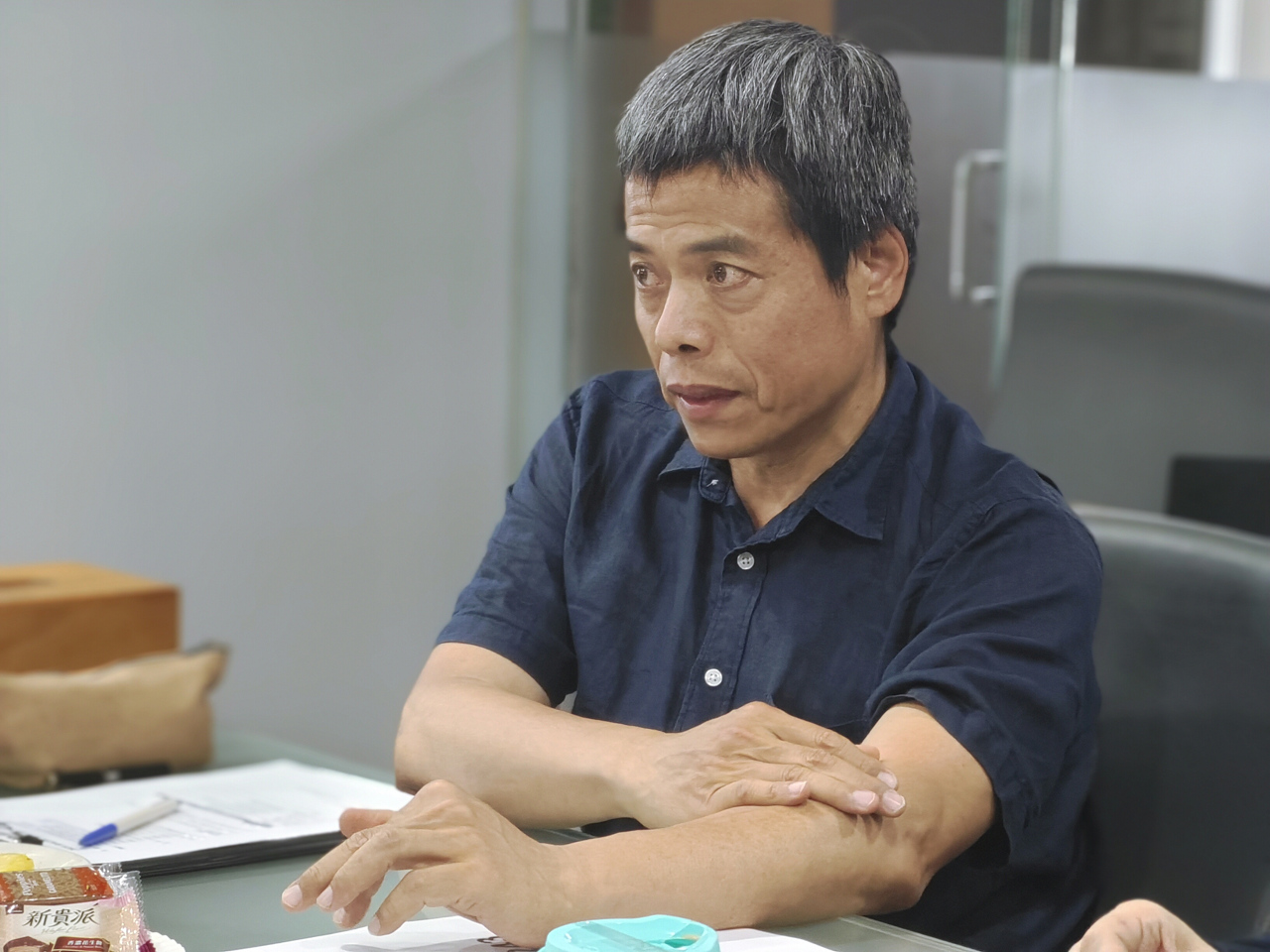
Ming-Yuan Kan/photo: ta
林家如:入圍作品Return To The ( )是提出一個大型的複合社區,訴求人不要只是動物,而是要更多的活動,故將人的居住空間壓縮到很小,留出較大的空間給公共需求,建立一種新的群居模式,兩位評審就問他是要提出設計原型,建議未來的社會結構,還是只單純將其看成為有公共空間的居住行為,但他似乎沒有做出具體的回答。
Chia-Ju Lin:The shortlisted project of “Return To The ( )”is an idea of apartment complex to address that people are not only animals but need more activities. The living spaces are quite small compared to large public spaces for residents to build a new group mode of living. Two judges ask him the idea is for the prototype of design for future social structure or just being treated as living behavior in the public spaces but he does not give a clear answer.
葉熾仁:我自己常用人是動物的這個動物性來思考,因為人有許多基因是被保留沒有被改變的,雖然科技改變了我們生活的形式,但元宇宙並無法取代吃喝拉撒睡這些基本需求。當他提出「人不要只是動物」時,已經有一個先入為主的觀念去切入,可惜空間配置缺乏邏輯性,比較像隨意的組裝,沒有說明公共空間跟居住的關係,如何讓居住者能舒適的使用這些機能,雖然很用力地去營造空間氛圍,但這些建築空間並不代表是社區。但若回到單純的住宅形式,這些功能又被制度化,可能這就是有趣的地方。
Chih-Jen Yeh:I often consider things with the character of humans as animals because lots of gene of human beings are kept. Although technology has changed our living styles, the metauniverse cannot replace basic demands of living such as eating or sleep. When the designer brings the concept of “People are not just animals”, preconception is existed already. It is pity that the arrangement of space lacks of logic with random assembling. There is no explanation of relationship between public space and living and how residents can use the system comfortably. Although designers put efforts to build the atmosphere of living spaces, these spaces do not present a community. However, if the idea goes back to pure housing style, the functions are systematized. It is possibly interesting.
曾成德:我覺得這件作品是在談「自由」跟「多元」,但他舉動物來對照是有些失焦,因為人也是動物,而動物又分成野生跟關在鐵籠裡的,所以應該是強調人在這個空間裡面的感受,譬如會在通道裡相遇,一起在戶外散步、種植等,繼而將人的自由度及規範建構出來。回頭談第三名的Carbon Lab of Circular Economy,這是一個名稱誘人且政治正確的作品,但實際上細看裡面在各種系統,如結構、環境及居住的著力很輕,並沒有跟上他提出的名稱,是可惜的地方。
C-David Tseng:I think this project is about "freedom" and "diversity" but the comparison with animals is somewhat out of focus. Humans are also animals and animals can be divided into wild and captive ones. Therefore, the focus should be on the human experience in spaces such as encountering each other in a passage, walking and planting outside together and then constructing freedom and norms. When talking about the third-place project of Carbon Lab of Circular Economy, it has an attracting name and a correct politics direction. Unfortunately, if we thoroughly review systems inside such as structure, environment and accommodation which are mentioned less and are unmatched with the name proposed.
葉熾仁:入圍作品No One is an Island有趣之處,是每個單元各自獨立,但透過單元跟單元的連結又結合為聚落,來打破原本住宅的邊界,給居住者更大的自主性,讓人在面對外面世界時可選擇要接觸或不接觸。
Chih-Jen Yeh:The shortlisted project of “No One is an Island” is interesting that each unit is individual. Units can be connected to form a community to break down the boundary of residence and give residents more control. The idea allows residents to decide whether going out or not to touch the world outside.
黃長美:現在參加競圖的世代對數位工具非常熟練,入圍作品「Spatial Folding of Urban 'Patches'」就是透過數位軟體進行演算,直接生成建築體,這是很顛覆的。
Chang-Mei Huang:The generation of participating the competition is quite familiar with the digital tools. The shortlisted project of “Spatial Folding of Urban 'Patches'” is to use the digital software to develop a building type. It is an overturned idea.
林家如:Spatial Folding of Urban 'Patches'雖是透過參數化設計生成建築,但她在設計的過程中發現原本程式產生的結果無法直接被運用,最後又人為的介入設計過程將空間組合成合理的平面架構,所以Rem跟David就問她,既然一開始決定選擇用智能生成的方式產生單元,但中途又加入的作者的設計主觀意志來調整,那這個作品到底該如何被定義?她好像也無法回答。相對這個用數位工具設計的案子,榮譽獎Urban ZIP.per則是回頭師法經典,提出的住宅平面圖跟策略與柯比意1952年的馬賽公寓很像,不同處是將公共空間拉到高樓層。因此,兩位評審就問他為什麼過了這麼久,卻還要跟過去學習?以及他從中有找到什麼新的價值嗎?同樣可惜的是也沒有得到回答。從這裡其實看的出來,紙上作品的內容也許大家都很有趣,但簡報的流暢度以及如何回應評審提問,才是最後10件作品被分成不同等級的獎項的關鍵。
最後想再補充的,是現在學生對住宅的議題不感興趣,但住宅明明是與每個人息息相關,可能原因是住宅的限制太多,需求也多,設計者需要花很多時間去理解生活,需要親身去體會住宅空間、社區關係等,因此先天讓創意受到限制,較難找到獨特的點切入,因而學生不願意去面對這個題目。我自己會鼓勵學生日常就去觀察生活環境、生活習慣等,從中慢慢找到屬於他們世代的居住空間特質,因為每個世代都需要建立這世代對住宅的觀點,而不僅是將住宅當成商品。
Chia-Ju Lin:The Spatial Folding of Urban 'Patches' uses parametric design to generate architecture but the designer finds that the results produced by the program could not be directly applied during the process. As a result, the interaction design is still needed to combine the spaces into a rational plan structure. So Rem and David asks her that if she decides to generate units by AI, why her subjective design is also used to do adjustment in the process and how to define the project? We can see that she does not answer the question. In contrast, the Honorable Mention project of “Urban ZIP.per” is to respect to classic works. The plans and strategy is quite similar with Unit d'Habitation, Marseille designed by Le Corbusier but public spaces are positioned in higher floors. Therefore, two judges ask him that why he wants to learn works in the past since the development of architecture has gone for a while? And what is the new value he finds in the process? Unfortunately, we do not have his answer. It is clear that people are interested in paper works but the fluency of presentation and the response for judges are the key of degrees of the 10 projects.
Last, students are not interested in residential houses nowadays but residential houses tie with our life. The reason may go to too many restrictions and demands in designing residential houses. Designers need to experience life, the space of houses and relationship of community in person so the creation is limited by lacking of unique points and these experiences in the beginning. Therefore, students are not willing to face the topic. I will encourage students to observe environment around us and daily habits to gradually find the characteristics of living spaces for themselves. Every generation has to build their aspects of residential houses for current generation instead of merely treating them as commodities.
甘銘源:這幾年因為社會住宅的需求被拋出來,而變成一個議題跟趨勢,讓學生開始感到興趣,從照顧弱勢階級及環境的角度去討論社會住宅,因這是台灣正在發生的事情,但真正應該開始重視跟推動改革的應該是台灣房地產市場。
Ming-Yuan Kan:The demand of social housing has been discussed and becomes a topic and trend in recent years. The situation has aroused the interest of students to discuss social housing through the angle of taking care minorities and environment. This are the real things happened in Taiwan now but Taiwan’s market of real estate should be valued and reformed from now on.
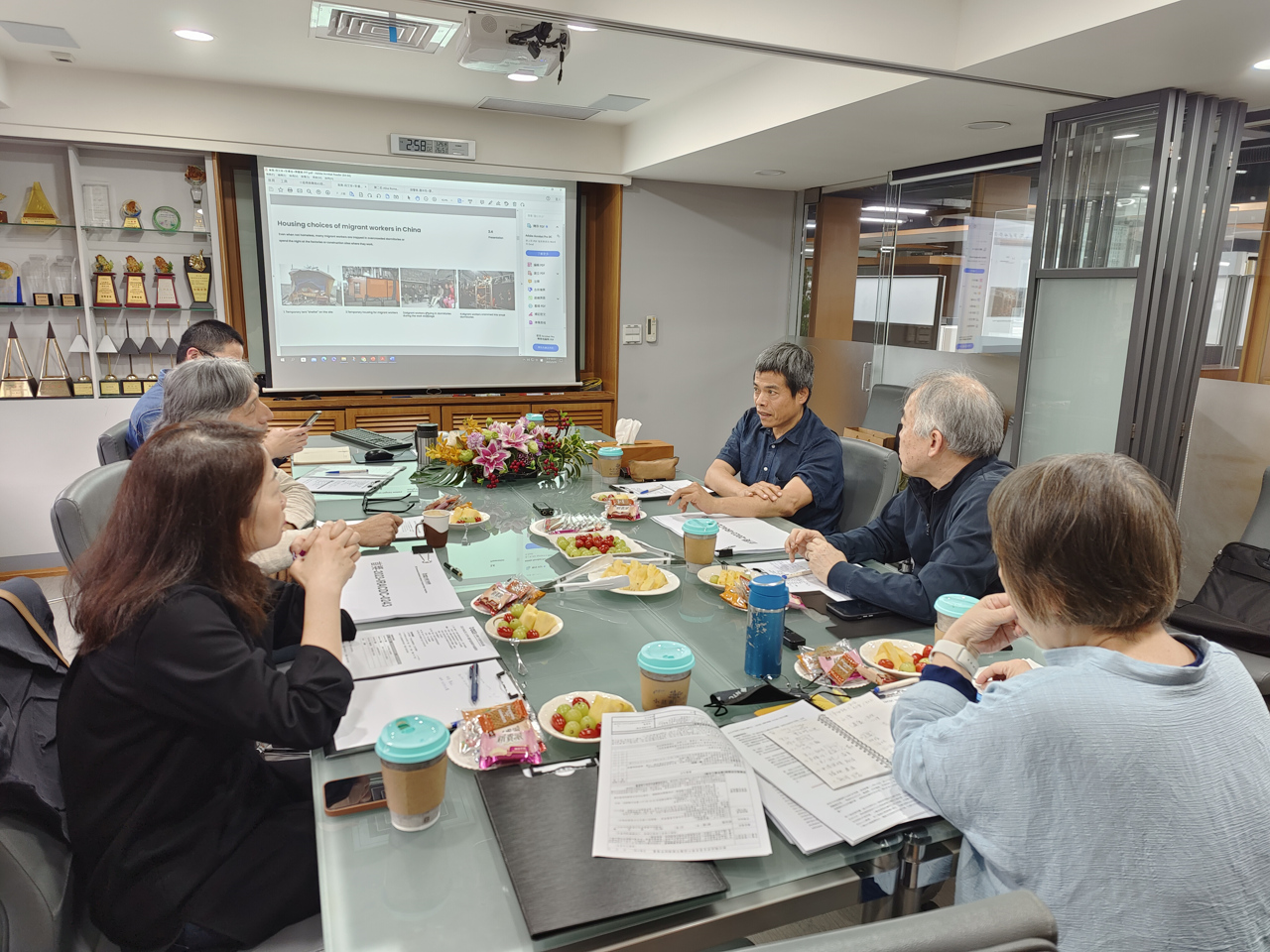
photo: ta
